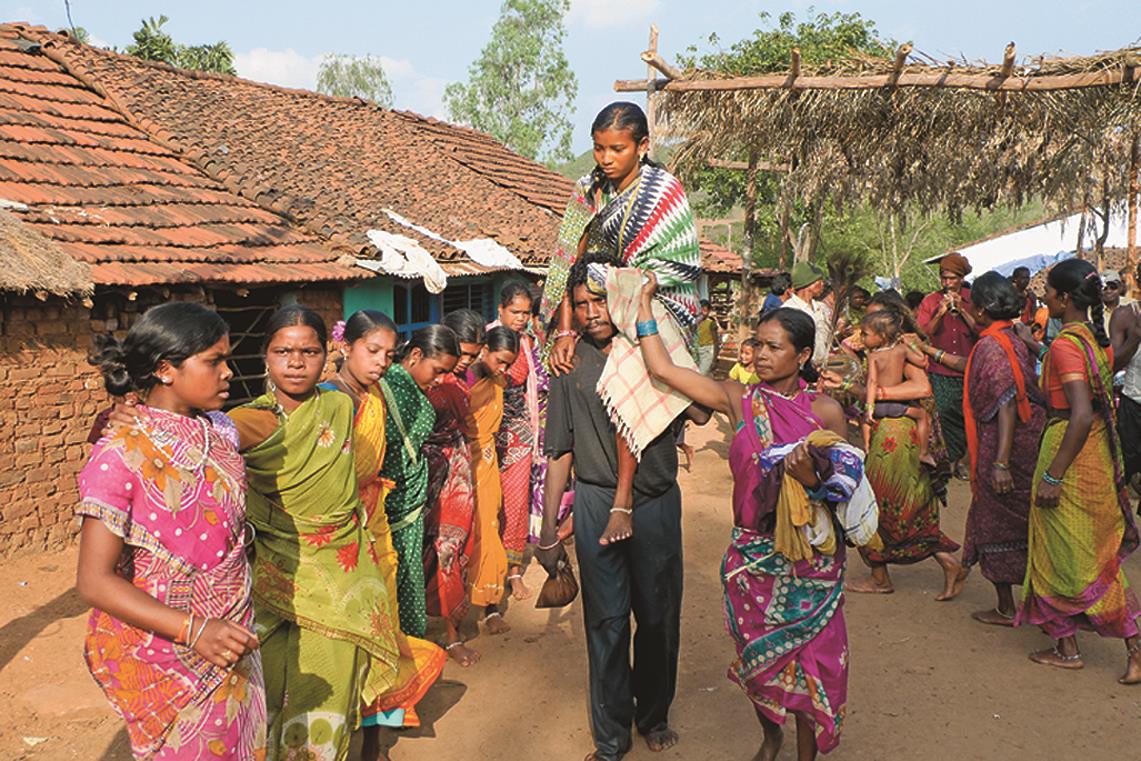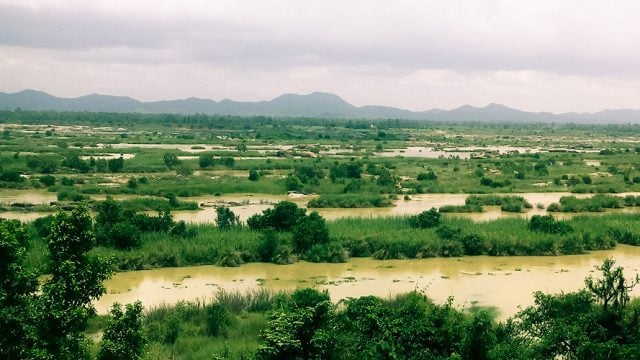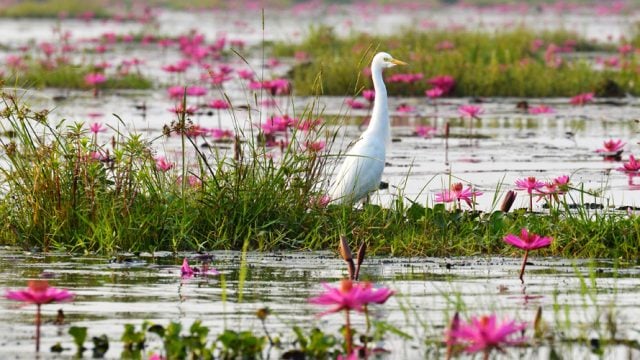A lookout was posted to wait for our car next to the tiny Kali temple at the
At the pump, women and girls were already splashing and teasing each other as we took photos and introduced ourselves with smiles. They talked to us mostly in laughter, with some Oriya and Hindi words thrown in. A pandal stood in the middle of the lane, the wet leaves on its canopy drooping, and that was the first hint that something special was afoot. The sound of music drew us to the stream east of the village, where a piper and two drummers kept up a sometimes tuneful but mostly repetitive din. At the water’s edge, a woman held a struggling bird and Rita explained that the women were sacrificing a chicken. Other offerings were assembled in banana leaves, put into clay pots and loaded — with a ritual ululation — on to the heads of freshly bathed and dressed young girls. They held the load, necks trembling with effort, till the priestess was ready; then they all came up the bank and went along to the house where a wedding was to be celebrated the next day.
Near the potter’s shed, the men had cast off their morning’s inertia with their shawls. One potter used a bamboo slat to shave thin strips off a hunk of clay and heaped them up. Then he went at that heap. He slapped it with his hands, he stomped on it with his feet, he ripped off hunks and slammed them down again. Next to him, a fellow chopped up a mess of clay with a spade. Another potter brought fresh clay in two baskets slung from a yoke and tipped it on to the ground. Curious to see the tasks upstream of all this, I followed one elderly potter around the shed, past three houses, over a patch of mud and stones and into the fields. We both crossed fields prickly with leftover straw until we reached what looked like the beginning of a tunnel in the ground. A boy was hunched into the hole, mining the clay with a pickaxe. While we waited for the boy to finish, my elderly potter introduced himself as “Tankadhar Kumbhar, paala (potter)”. He explained that he was collecting red soil here. Black soil was being gathered from a field further on and the two would be mixed together at the shed. They would then wet the clods and beat the clay into submission until it was homogeneous and free of straw and stones.
Back at the potter’s shed, I now discerned the two kinds of clay being mixed together in the heaps. Megha at the wheel shaped small pots and left them on one side to dry. Brindavan Kumbhar checked to see how dry they were. Then he picked one and began his slow music on the clay, pressing it with one hand on the inside and thumping it from the outside till it ballooned to a much larger pot. Inside, a boy on the wheel formed diyas, slicing off each finished piece with a string. All this time, women walked to and fro with neat bundles of firewood. A very short boy set forth with a very long axe. There was very little chatter, only the dup-dup-dup from Brindavan, the muffled whirr of the wheel, the clatter of falling rocks, the slap of hands on wet clay, cheeps and clucks from the chickens and the cooroos of white doves. Overhead, the dry rustle of eucalyptus and bamboo leaves.
The spaces around the shed, with hens scratching the ground and goats stumbling over each other, are the true commons. This is where the villagers pound grain, cook, eat, bathe, work and wed. Their private, owned spaces are rooms just large enough for sleeping in and storing a few things. If you looked in those rooms, you’d find most of them empty.
Seen from a nearby hillock, the roofs of the village form a tiny string shaded by mango trees. Most of the land is given up to productivity, not shelter. It is pasture and farm fields. It is not an adventurous landscape like the Himalaya, or even as wildly beautiful as the Western Ghats. But farm fields are heroic in their own way. The tribes on these hills shape the idiosyncratic curves and wrinkles of a slope into perfectly flat terraces, systematically directing the water from the stream at the top from one field to the next. Cabbages and greens are impressive in their geometrically regular rows, but the planting of rice is nothing short of miraculous. As is the very tiny ecological footprint of the tribes. For centuries they have lived on this land and it is still rich.
There is a homestay called Chandoori Sai not far from the rice fields, run by “Foreign Saar”. Our first meal there could be called fusion, if you wanted to put lipstick on it, but really it’s just home cooking from Leon Mahoney, the Australian who lives here. He makes his own bread, pasta and ice cream and, for the rest, he cooks what he knows, helped by Rita, Jemma, Pothima and the other women who work here. We ate eggplant and potato baked with sauce and melted cheese, served with fresh bread and followed by fruit salad. The next morning’s omelette was so correctly made, it needed no salt or pepper. Our coffee was brewed from locally grown beans roasted in a clay pot out back.
In the garden are basil, thyme, parsley, asparagus shoots, bok choy and cherry tomatoes, grown in pots and raised beds. A few chicks peep out of the old kiln in which Leon and the village women fired the roof tiles and floor tiles of this house. In the corner is a stone tool shed the women built themselves. Small minivets and striated bulbuls inhabit a Delonix regia and sunbirds flit in and out of a jackfruit tree. The most welcome sight to my eyes is the plain house sparrow. The rooms are Australian in scale and local in colour, with generous verandas, but we are outdoors most of the time, where the action is.
It is the women who give the house its buzz. They dress up the photographer in a tribal sari and nose rings so that we can take pictures. They pin circles of flowers in our hair. They trim the lawn with sheep shears while we pick up cherries from the ground and pop them into our mouths and photograph the women’s chandelier-like anklets, their earrings and their flowers. Even with all our chatter, the grass gets trimmed.
The market at Podagada was just setting up as we tagged along on Leon’s morning shopping excursion. Fat radishes gleamed alongside slender onion stalks and about ten types of fish were laid out on tarps. Turmeric rhizomes, red chillies and rock salt lay in heaps, ready to be weighed out. A man broke up his hunk of gur with a hammer and nail. Women in tribal gear bought soap and bangles. Men picked out wrinkled sheaves of tobacco. We all walked on a carpet of dried ficus leaves and sometimes squished fresh dung underfoot.
In the afternoon, the drumming called us back to the village. We followed the wedding party to the stream, where the bride and groom, crowned in mango leaves, were dunked in the water. Others, more or less drunk, also fell in. Then the freshly dressed couple were carried home on their uncles’ shoulders, while a line of women, arms linked, danced around and around them.
As the light faded, all was quiet at the potter’s shed. Most everyone was at the wedding. But the day’s tasks were not done. A mound of wet clay lay uncovered, next to a half-shaved heap. Sure enough, as I turned homeward, I met Brindavan returning to tidy up. Behind him was Tankadhar, who gave me a generous handful of sweetened puffed rice. Through sticky mouthfuls we said our goodbyes and he invited me to come to Goudaguda again, and again.
rural tourism
tribal
village life
Leave a Reply
You must be logged in to post a comment.





